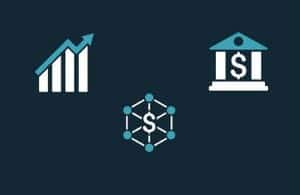
Revenue models of existing banks may become obsolete as blockchain gains market acceptance. Three areas in finance will likely be the first to see disruption.
An increasing number of banks are realizing the urgency of blockchain and are exploring ways of using the technology. Although the distributed ledger technology has the potential to change and improve financial services, it does not constitute a one-size-fits-all solution. Potential business cases need to fit to the technology’s specific characteristics, which are:
Security — all transactions recorded in the blockchain are immutable and transparent. Therefore, the application of the technology is appropriate for use cases in which security plays a major role.
Decentralization — enables business models that replace any trusted third party or intermediary because a trust relationship between unknown parties is established.
Any asset possible — tokens used by the network allow the exchange of any physical or non-physical asset so that the blockchain can be used for different kinds of transactions.
Internet as basis – the blockchain uses the internet as the underlying infrastructure to process transactions. This enables business cases to provide banking services without the need for a banking infrastructure.
Lower costs, higher speed — in some cases, the blockchain could reduce transaction costs and increase transaction speed. This feature depends mainly on the number of transactions and the network size.
In light of this, the distributed ledger technology can develop its full potential only if the criteria mentioned are fulfilled. Still, the technology is showing exciting and transformative signs. The three main fields ripest for blockchain applications in financial services are payment transactions, trade finance, and the over-the-counter market. Here’s how blockchain technology could be used or is already being deployed in these segments.
Payment transactions

Payment systems are based on local laws and practices within existing domestic banking, and the lack of a common global standard reduces the ability to seamlessly pass data and back-office information, creating both settlement and non-settlement risks.
A broad implementation and use of the blockchain technology would change and disrupt the financial services industry and payment systems on an international scale. Processes would alter in terms of time required, and the revenue models of many financial institutions might become obsolete. The technology has the power not only to shape payment and settlement processes more rapidly, cheaply and safely, but also to redefine the entire system of international money transfers.
Trade finance

Nonetheless, digitization has begun to make its way into trade finance and has generated first attempts to reduce costs and cycle times.
Despite the progress to date, a breakthrough innovation in this segment is still to come. Currently no solutions exist to core problems, such as a digital representation for the transfer of ownership or an automated checking of letter of credit conditions. Fraud via double financing or the scarcity of trade finance products in developing and emerging markets are further issues that cannot be fixed with the limited closed-shop architecture of current digital products.
To deliver noticeable value, blockchain-based solutions have to address the different needs of trading partners, financial institutions and freight carriers. Moreover, certain legal and technological requirements must be met.
Especially for trading companies, low barriers to entry like the elimination of fixed costs are important to allow widespread adoption. High security and privacy standards are also a basic prerequisite in international trade. Beyond that, the trading sector – or at least parts of it – is in need of a means to eliminate counterfeit products from international markets. Standard trade finance products are usually characterized by a trade-off between low cost and high security. Now, for the first time, a technology can overcome this trade-off while offering the possibility of collaboration in a secure way over long distances at low process-related costs. The success of individual companies will strongly depend on effective networking and openness to collaboration.
OTC market infrastructure

The recent financial crises forced regulators in the United States and Europe to increase market transparency and to reduce the risk of market procedures. However, reliance on trusted third parties for validation increases the complexity of the system and clients’ costs rise owing to an extended number of market participants that have to be rewarded. To comply with the requirements, banks and other financial institutions have to maintain extensive back offices to manage processes and to monitor contracts.
By implementing blockchain technology, market participants could not only eliminate inefficiencies but also reshape business models by exploiting its main potentials. Besides simplifying the market, the technology enables the implementation of smart contracts in the OTC markets as well, as already seen in trade finance. Especially large investment banks will require favorable regulations for their operations in the area of blockchain technology.
Predicted time for broad implementation
Blockchain applications in finance have the potential to completely change processes and systems. Blockchain could remove trusted third parties, decrease costs and ultimately increase profits for various players within the financial services industry. However, it is not a one-size-fits-all solution, as potential use cases need to fit to the technology’s specific characteristics and requirements.
Current research is exploring whether public or private blockchain networks are more appropriate for business use cases. Although public blockchains provide high data security and transparency, they are relatively slow if a high number of transactions needs to be processed. Private blockchains instead enable higher transaction speeds and more privacy but often come along with lower security standards.
Since both network architectures have their unique advantages and disadvantages, it is possible that private and public blockchains will merge in the future. While the technology is still in an early stage and has to prove itself in practice, within five to 10 years, blockchain will be available for broad use in financial services.
Related:




























